Hospitality Operations Report: Food and Beverage Management
VerifiedAdded on 2023/01/17
|12
|4740
|71
Report
AI Summary
This report provides a comprehensive analysis of hospitality operations, focusing on food and beverage services and food production within the context of the Hilton Hotel. It explores the creativity and synthesis of food and beverage services, examining various service types and innovative strategies employed by hotels to attract customers. The report delves into the roles and responsibilities of restaurant managers, highlighting their crucial functions in customer service, record-keeping, food quality, and staff management. Furthermore, it examines the factors influencing menu pricing, including transportation costs, and analyzes menu planning considerations and constraints. The report aims to provide insights into effective hospitality management practices and strategies for success in the competitive food and beverage industry.
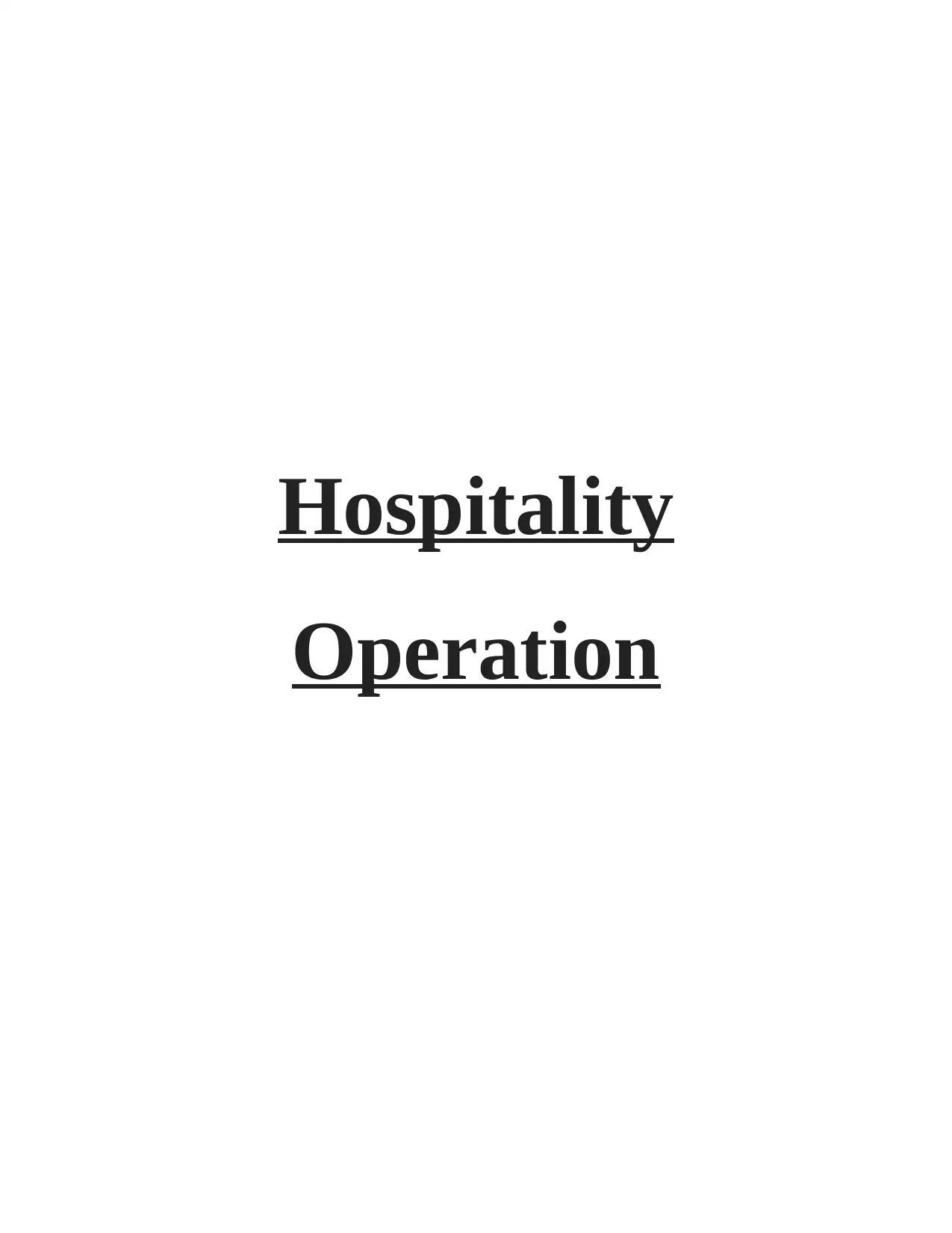
Hospitality
Operation
Operation
Paraphrase This Document
Need a fresh take? Get an instant paraphrase of this document with our AI Paraphraser
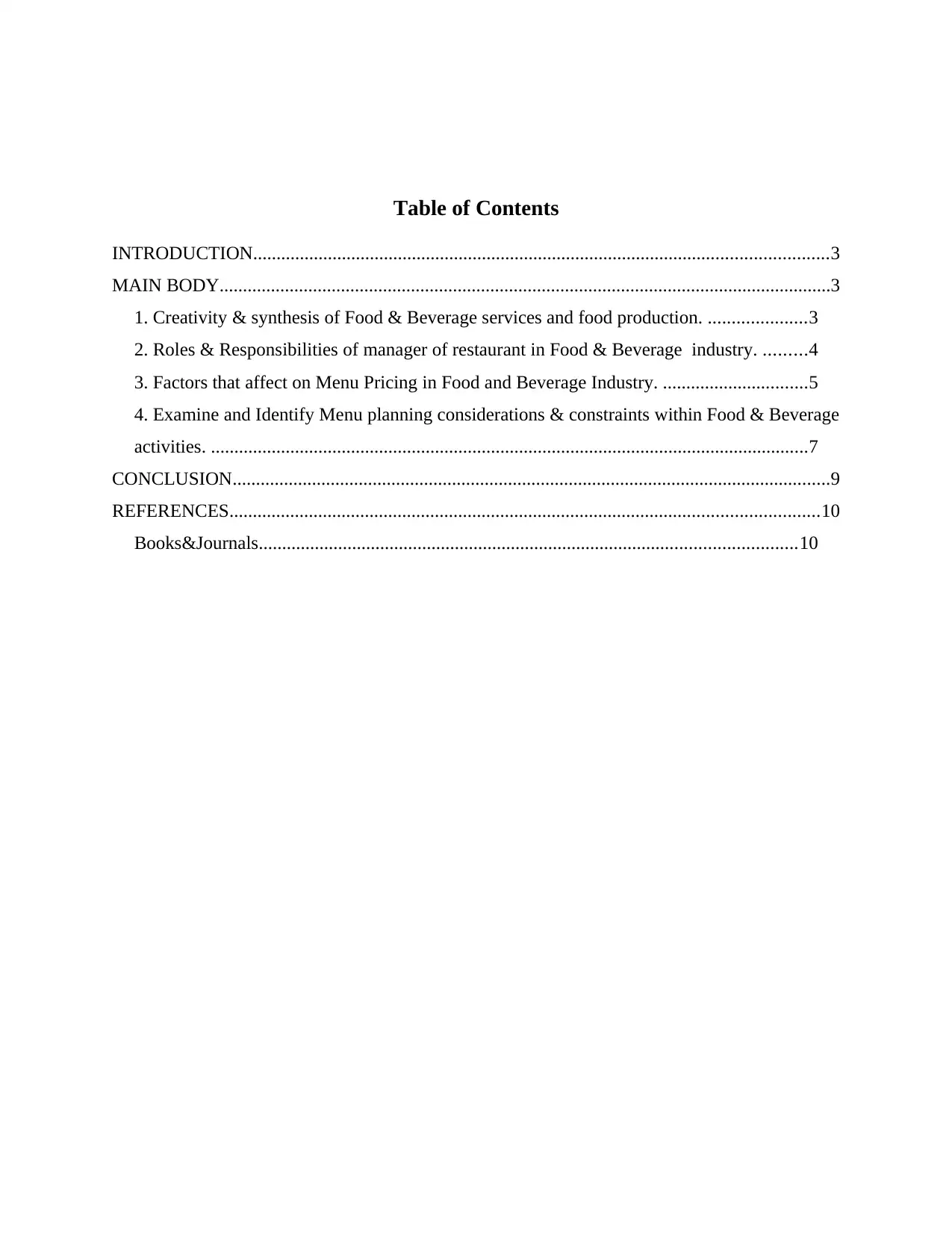
Table of Contents
INTRODUCTION...........................................................................................................................3
MAIN BODY...................................................................................................................................3
1. Creativity & synthesis of Food & Beverage services and food production. .....................3
2. Roles & Responsibilities of manager of restaurant in Food & Beverage industry. .........4
3. Factors that affect on Menu Pricing in Food and Beverage Industry. ...............................5
4. Examine and Identify Menu planning considerations & constraints within Food & Beverage
activities. ................................................................................................................................7
CONCLUSION................................................................................................................................9
REFERENCES..............................................................................................................................10
Books&Journals...................................................................................................................10
INTRODUCTION...........................................................................................................................3
MAIN BODY...................................................................................................................................3
1. Creativity & synthesis of Food & Beverage services and food production. .....................3
2. Roles & Responsibilities of manager of restaurant in Food & Beverage industry. .........4
3. Factors that affect on Menu Pricing in Food and Beverage Industry. ...............................5
4. Examine and Identify Menu planning considerations & constraints within Food & Beverage
activities. ................................................................................................................................7
CONCLUSION................................................................................................................................9
REFERENCES..............................................................................................................................10
Books&Journals...................................................................................................................10
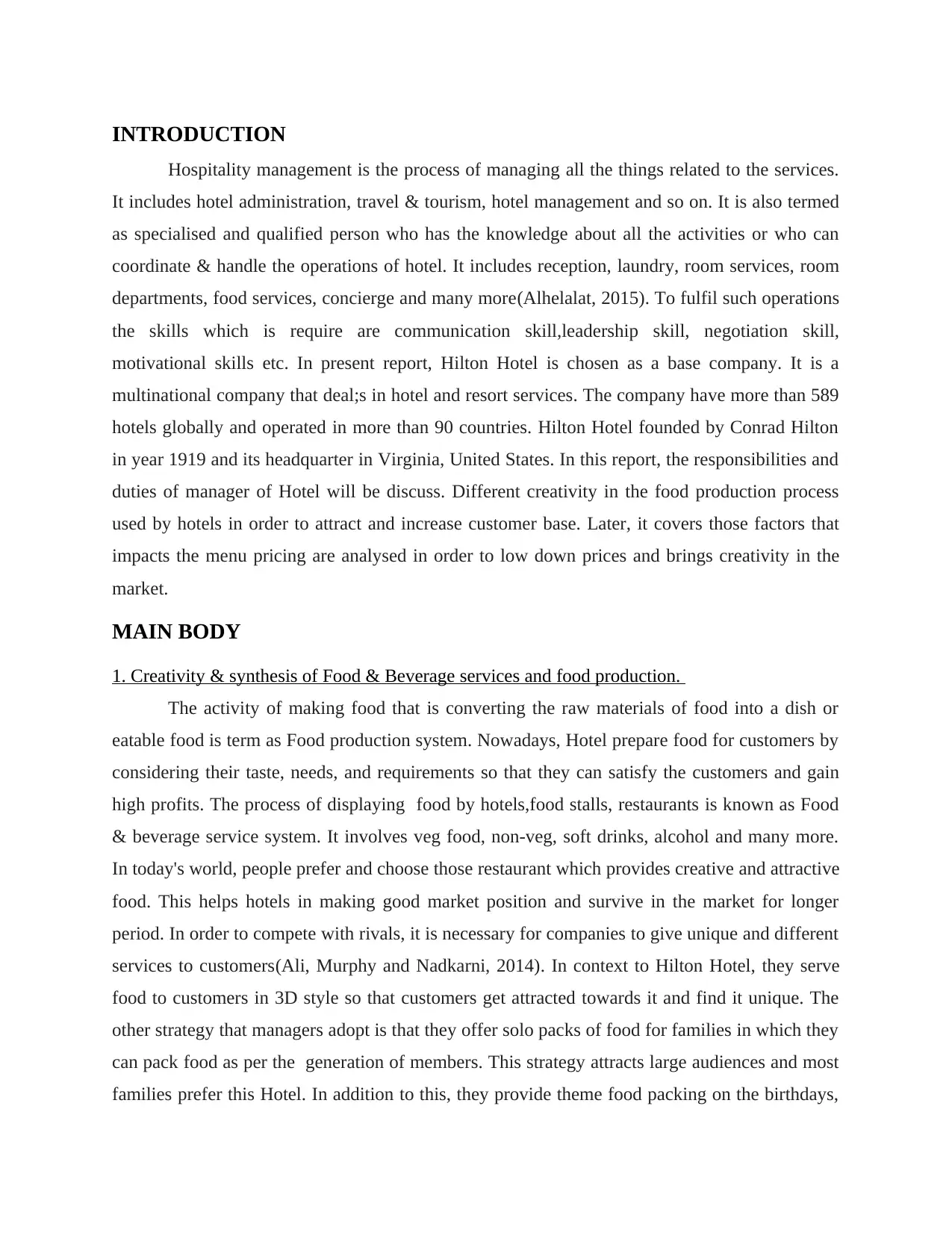
INTRODUCTION
Hospitality management is the process of managing all the things related to the services.
It includes hotel administration, travel & tourism, hotel management and so on. It is also termed
as specialised and qualified person who has the knowledge about all the activities or who can
coordinate & handle the operations of hotel. It includes reception, laundry, room services, room
departments, food services, concierge and many more(Alhelalat, 2015). To fulfil such operations
the skills which is require are communication skill,leadership skill, negotiation skill,
motivational skills etc. In present report, Hilton Hotel is chosen as a base company. It is a
multinational company that deal;s in hotel and resort services. The company have more than 589
hotels globally and operated in more than 90 countries. Hilton Hotel founded by Conrad Hilton
in year 1919 and its headquarter in Virginia, United States. In this report, the responsibilities and
duties of manager of Hotel will be discuss. Different creativity in the food production process
used by hotels in order to attract and increase customer base. Later, it covers those factors that
impacts the menu pricing are analysed in order to low down prices and brings creativity in the
market.
MAIN BODY
1. Creativity & synthesis of Food & Beverage services and food production.
The activity of making food that is converting the raw materials of food into a dish or
eatable food is term as Food production system. Nowadays, Hotel prepare food for customers by
considering their taste, needs, and requirements so that they can satisfy the customers and gain
high profits. The process of displaying food by hotels,food stalls, restaurants is known as Food
& beverage service system. It involves veg food, non-veg, soft drinks, alcohol and many more.
In today's world, people prefer and choose those restaurant which provides creative and attractive
food. This helps hotels in making good market position and survive in the market for longer
period. In order to compete with rivals, it is necessary for companies to give unique and different
services to customers(Ali, Murphy and Nadkarni, 2014). In context to Hilton Hotel, they serve
food to customers in 3D style so that customers get attracted towards it and find it unique. The
other strategy that managers adopt is that they offer solo packs of food for families in which they
can pack food as per the generation of members. This strategy attracts large audiences and most
families prefer this Hotel. In addition to this, they provide theme food packing on the birthdays,
Hospitality management is the process of managing all the things related to the services.
It includes hotel administration, travel & tourism, hotel management and so on. It is also termed
as specialised and qualified person who has the knowledge about all the activities or who can
coordinate & handle the operations of hotel. It includes reception, laundry, room services, room
departments, food services, concierge and many more(Alhelalat, 2015). To fulfil such operations
the skills which is require are communication skill,leadership skill, negotiation skill,
motivational skills etc. In present report, Hilton Hotel is chosen as a base company. It is a
multinational company that deal;s in hotel and resort services. The company have more than 589
hotels globally and operated in more than 90 countries. Hilton Hotel founded by Conrad Hilton
in year 1919 and its headquarter in Virginia, United States. In this report, the responsibilities and
duties of manager of Hotel will be discuss. Different creativity in the food production process
used by hotels in order to attract and increase customer base. Later, it covers those factors that
impacts the menu pricing are analysed in order to low down prices and brings creativity in the
market.
MAIN BODY
1. Creativity & synthesis of Food & Beverage services and food production.
The activity of making food that is converting the raw materials of food into a dish or
eatable food is term as Food production system. Nowadays, Hotel prepare food for customers by
considering their taste, needs, and requirements so that they can satisfy the customers and gain
high profits. The process of displaying food by hotels,food stalls, restaurants is known as Food
& beverage service system. It involves veg food, non-veg, soft drinks, alcohol and many more.
In today's world, people prefer and choose those restaurant which provides creative and attractive
food. This helps hotels in making good market position and survive in the market for longer
period. In order to compete with rivals, it is necessary for companies to give unique and different
services to customers(Ali, Murphy and Nadkarni, 2014). In context to Hilton Hotel, they serve
food to customers in 3D style so that customers get attracted towards it and find it unique. The
other strategy that managers adopt is that they offer solo packs of food for families in which they
can pack food as per the generation of members. This strategy attracts large audiences and most
families prefer this Hotel. In addition to this, they provide theme food packing on the birthdays,
⊘ This is a preview!⊘
Do you want full access?
Subscribe today to unlock all pages.

Trusted by 1+ million students worldwide
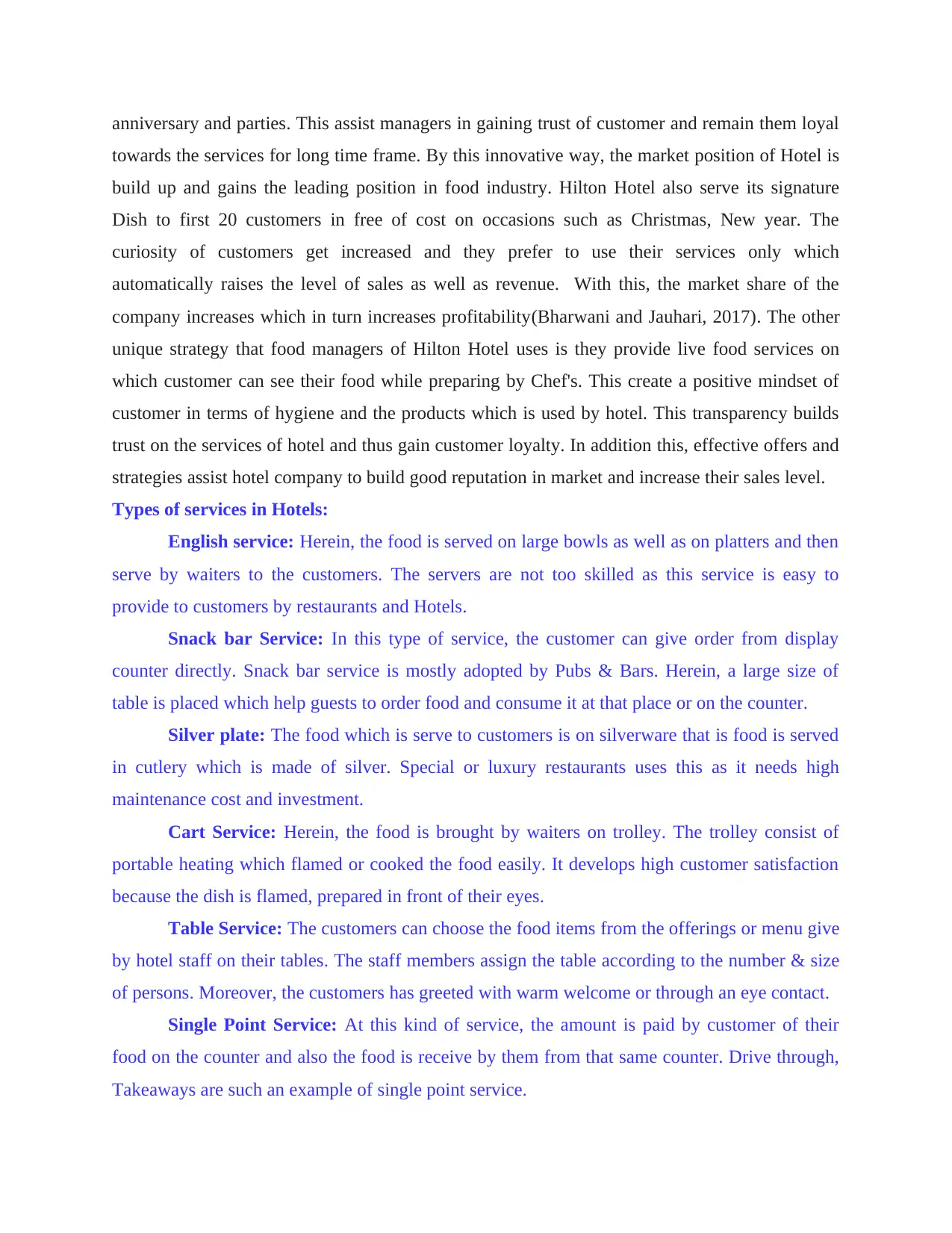
anniversary and parties. This assist managers in gaining trust of customer and remain them loyal
towards the services for long time frame. By this innovative way, the market position of Hotel is
build up and gains the leading position in food industry. Hilton Hotel also serve its signature
Dish to first 20 customers in free of cost on occasions such as Christmas, New year. The
curiosity of customers get increased and they prefer to use their services only which
automatically raises the level of sales as well as revenue. With this, the market share of the
company increases which in turn increases profitability(Bharwani and Jauhari, 2017). The other
unique strategy that food managers of Hilton Hotel uses is they provide live food services on
which customer can see their food while preparing by Chef's. This create a positive mindset of
customer in terms of hygiene and the products which is used by hotel. This transparency builds
trust on the services of hotel and thus gain customer loyalty. In addition this, effective offers and
strategies assist hotel company to build good reputation in market and increase their sales level.
Types of services in Hotels:
English service: Herein, the food is served on large bowls as well as on platters and then
serve by waiters to the customers. The servers are not too skilled as this service is easy to
provide to customers by restaurants and Hotels.
Snack bar Service: In this type of service, the customer can give order from display
counter directly. Snack bar service is mostly adopted by Pubs & Bars. Herein, a large size of
table is placed which help guests to order food and consume it at that place or on the counter.
Silver plate: The food which is serve to customers is on silverware that is food is served
in cutlery which is made of silver. Special or luxury restaurants uses this as it needs high
maintenance cost and investment.
Cart Service: Herein, the food is brought by waiters on trolley. The trolley consist of
portable heating which flamed or cooked the food easily. It develops high customer satisfaction
because the dish is flamed, prepared in front of their eyes.
Table Service: The customers can choose the food items from the offerings or menu give
by hotel staff on their tables. The staff members assign the table according to the number & size
of persons. Moreover, the customers has greeted with warm welcome or through an eye contact.
Single Point Service: At this kind of service, the amount is paid by customer of their
food on the counter and also the food is receive by them from that same counter. Drive through,
Takeaways are such an example of single point service.
towards the services for long time frame. By this innovative way, the market position of Hotel is
build up and gains the leading position in food industry. Hilton Hotel also serve its signature
Dish to first 20 customers in free of cost on occasions such as Christmas, New year. The
curiosity of customers get increased and they prefer to use their services only which
automatically raises the level of sales as well as revenue. With this, the market share of the
company increases which in turn increases profitability(Bharwani and Jauhari, 2017). The other
unique strategy that food managers of Hilton Hotel uses is they provide live food services on
which customer can see their food while preparing by Chef's. This create a positive mindset of
customer in terms of hygiene and the products which is used by hotel. This transparency builds
trust on the services of hotel and thus gain customer loyalty. In addition this, effective offers and
strategies assist hotel company to build good reputation in market and increase their sales level.
Types of services in Hotels:
English service: Herein, the food is served on large bowls as well as on platters and then
serve by waiters to the customers. The servers are not too skilled as this service is easy to
provide to customers by restaurants and Hotels.
Snack bar Service: In this type of service, the customer can give order from display
counter directly. Snack bar service is mostly adopted by Pubs & Bars. Herein, a large size of
table is placed which help guests to order food and consume it at that place or on the counter.
Silver plate: The food which is serve to customers is on silverware that is food is served
in cutlery which is made of silver. Special or luxury restaurants uses this as it needs high
maintenance cost and investment.
Cart Service: Herein, the food is brought by waiters on trolley. The trolley consist of
portable heating which flamed or cooked the food easily. It develops high customer satisfaction
because the dish is flamed, prepared in front of their eyes.
Table Service: The customers can choose the food items from the offerings or menu give
by hotel staff on their tables. The staff members assign the table according to the number & size
of persons. Moreover, the customers has greeted with warm welcome or through an eye contact.
Single Point Service: At this kind of service, the amount is paid by customer of their
food on the counter and also the food is receive by them from that same counter. Drive through,
Takeaways are such an example of single point service.
Paraphrase This Document
Need a fresh take? Get an instant paraphrase of this document with our AI Paraphraser
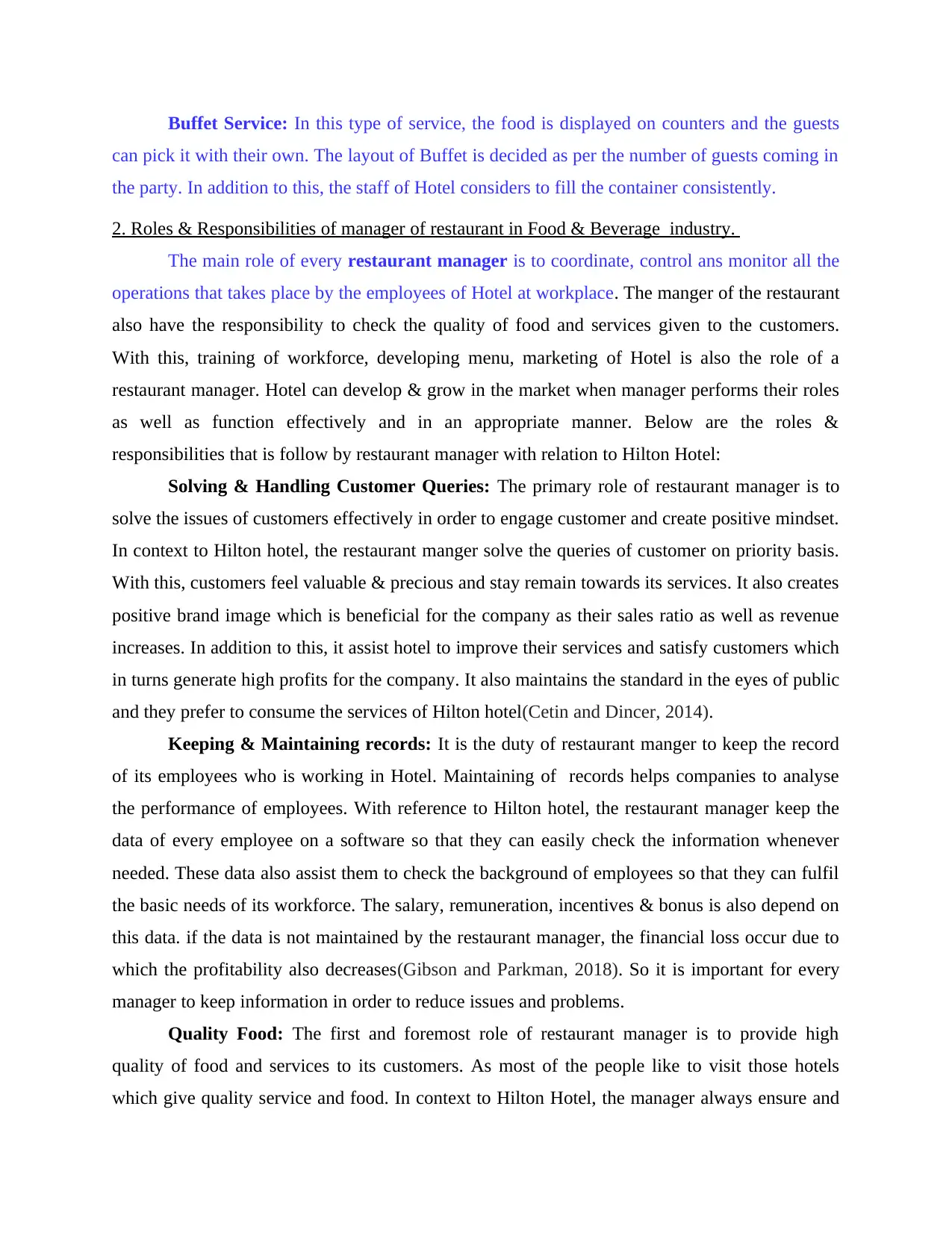
Buffet Service: In this type of service, the food is displayed on counters and the guests
can pick it with their own. The layout of Buffet is decided as per the number of guests coming in
the party. In addition to this, the staff of Hotel considers to fill the container consistently.
2. Roles & Responsibilities of manager of restaurant in Food & Beverage industry.
The main role of every restaurant manager is to coordinate, control ans monitor all the
operations that takes place by the employees of Hotel at workplace. The manger of the restaurant
also have the responsibility to check the quality of food and services given to the customers.
With this, training of workforce, developing menu, marketing of Hotel is also the role of a
restaurant manager. Hotel can develop & grow in the market when manager performs their roles
as well as function effectively and in an appropriate manner. Below are the roles &
responsibilities that is follow by restaurant manager with relation to Hilton Hotel:
Solving & Handling Customer Queries: The primary role of restaurant manager is to
solve the issues of customers effectively in order to engage customer and create positive mindset.
In context to Hilton hotel, the restaurant manger solve the queries of customer on priority basis.
With this, customers feel valuable & precious and stay remain towards its services. It also creates
positive brand image which is beneficial for the company as their sales ratio as well as revenue
increases. In addition to this, it assist hotel to improve their services and satisfy customers which
in turns generate high profits for the company. It also maintains the standard in the eyes of public
and they prefer to consume the services of Hilton hotel(Cetin and Dincer, 2014).
Keeping & Maintaining records: It is the duty of restaurant manger to keep the record
of its employees who is working in Hotel. Maintaining of records helps companies to analyse
the performance of employees. With reference to Hilton hotel, the restaurant manager keep the
data of every employee on a software so that they can easily check the information whenever
needed. These data also assist them to check the background of employees so that they can fulfil
the basic needs of its workforce. The salary, remuneration, incentives & bonus is also depend on
this data. if the data is not maintained by the restaurant manager, the financial loss occur due to
which the profitability also decreases(Gibson and Parkman, 2018). So it is important for every
manager to keep information in order to reduce issues and problems.
Quality Food: The first and foremost role of restaurant manager is to provide high
quality of food and services to its customers. As most of the people like to visit those hotels
which give quality service and food. In context to Hilton Hotel, the manager always ensure and
can pick it with their own. The layout of Buffet is decided as per the number of guests coming in
the party. In addition to this, the staff of Hotel considers to fill the container consistently.
2. Roles & Responsibilities of manager of restaurant in Food & Beverage industry.
The main role of every restaurant manager is to coordinate, control ans monitor all the
operations that takes place by the employees of Hotel at workplace. The manger of the restaurant
also have the responsibility to check the quality of food and services given to the customers.
With this, training of workforce, developing menu, marketing of Hotel is also the role of a
restaurant manager. Hotel can develop & grow in the market when manager performs their roles
as well as function effectively and in an appropriate manner. Below are the roles &
responsibilities that is follow by restaurant manager with relation to Hilton Hotel:
Solving & Handling Customer Queries: The primary role of restaurant manager is to
solve the issues of customers effectively in order to engage customer and create positive mindset.
In context to Hilton hotel, the restaurant manger solve the queries of customer on priority basis.
With this, customers feel valuable & precious and stay remain towards its services. It also creates
positive brand image which is beneficial for the company as their sales ratio as well as revenue
increases. In addition to this, it assist hotel to improve their services and satisfy customers which
in turns generate high profits for the company. It also maintains the standard in the eyes of public
and they prefer to consume the services of Hilton hotel(Cetin and Dincer, 2014).
Keeping & Maintaining records: It is the duty of restaurant manger to keep the record
of its employees who is working in Hotel. Maintaining of records helps companies to analyse
the performance of employees. With reference to Hilton hotel, the restaurant manager keep the
data of every employee on a software so that they can easily check the information whenever
needed. These data also assist them to check the background of employees so that they can fulfil
the basic needs of its workforce. The salary, remuneration, incentives & bonus is also depend on
this data. if the data is not maintained by the restaurant manager, the financial loss occur due to
which the profitability also decreases(Gibson and Parkman, 2018). So it is important for every
manager to keep information in order to reduce issues and problems.
Quality Food: The first and foremost role of restaurant manager is to provide high
quality of food and services to its customers. As most of the people like to visit those hotels
which give quality service and food. In context to Hilton Hotel, the manager always ensure and
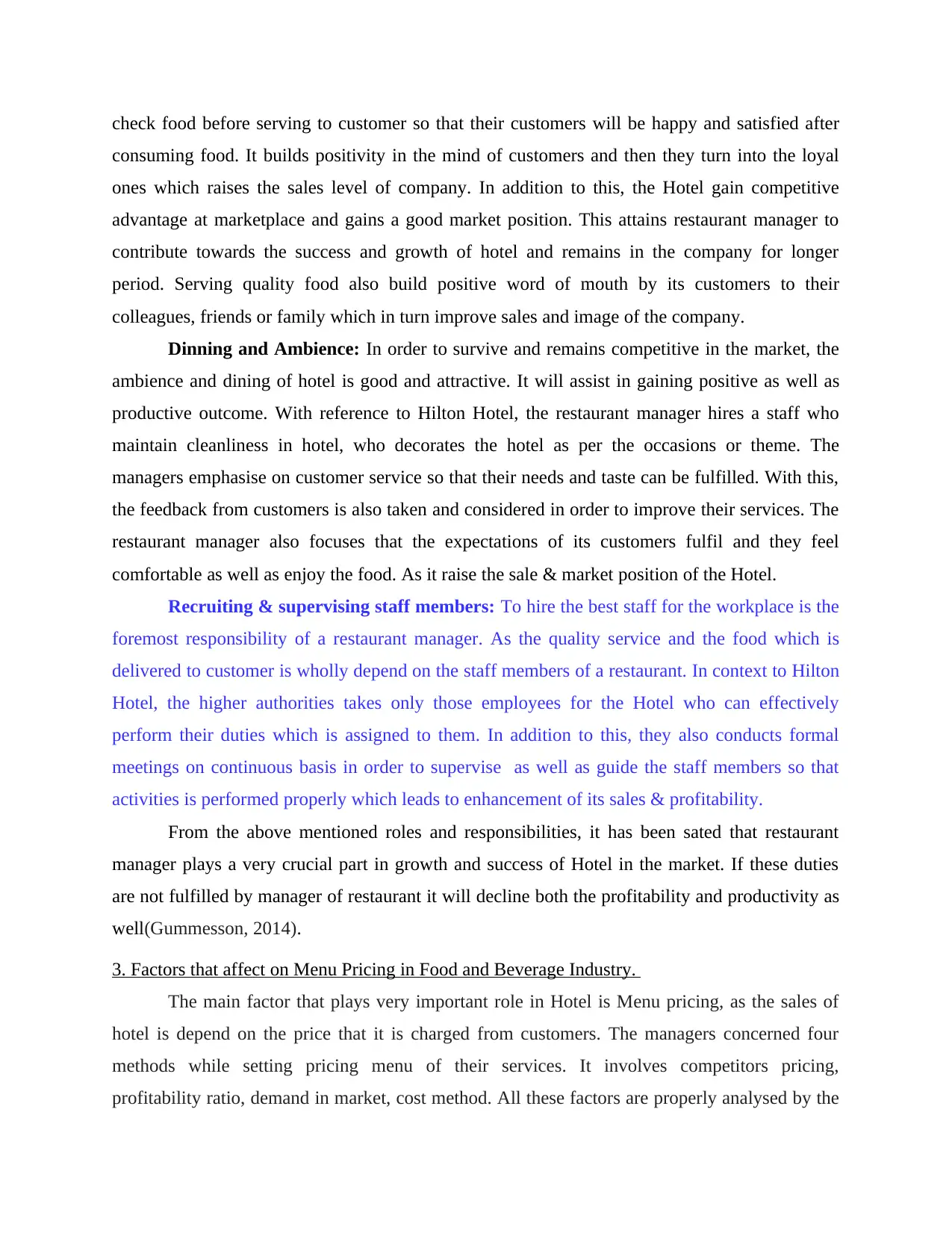
check food before serving to customer so that their customers will be happy and satisfied after
consuming food. It builds positivity in the mind of customers and then they turn into the loyal
ones which raises the sales level of company. In addition to this, the Hotel gain competitive
advantage at marketplace and gains a good market position. This attains restaurant manager to
contribute towards the success and growth of hotel and remains in the company for longer
period. Serving quality food also build positive word of mouth by its customers to their
colleagues, friends or family which in turn improve sales and image of the company.
Dinning and Ambience: In order to survive and remains competitive in the market, the
ambience and dining of hotel is good and attractive. It will assist in gaining positive as well as
productive outcome. With reference to Hilton Hotel, the restaurant manager hires a staff who
maintain cleanliness in hotel, who decorates the hotel as per the occasions or theme. The
managers emphasise on customer service so that their needs and taste can be fulfilled. With this,
the feedback from customers is also taken and considered in order to improve their services. The
restaurant manager also focuses that the expectations of its customers fulfil and they feel
comfortable as well as enjoy the food. As it raise the sale & market position of the Hotel.
Recruiting & supervising staff members: To hire the best staff for the workplace is the
foremost responsibility of a restaurant manager. As the quality service and the food which is
delivered to customer is wholly depend on the staff members of a restaurant. In context to Hilton
Hotel, the higher authorities takes only those employees for the Hotel who can effectively
perform their duties which is assigned to them. In addition to this, they also conducts formal
meetings on continuous basis in order to supervise as well as guide the staff members so that
activities is performed properly which leads to enhancement of its sales & profitability.
From the above mentioned roles and responsibilities, it has been sated that restaurant
manager plays a very crucial part in growth and success of Hotel in the market. If these duties
are not fulfilled by manager of restaurant it will decline both the profitability and productivity as
well(Gummesson, 2014).
3. Factors that affect on Menu Pricing in Food and Beverage Industry.
The main factor that plays very important role in Hotel is Menu pricing, as the sales of
hotel is depend on the price that it is charged from customers. The managers concerned four
methods while setting pricing menu of their services. It involves competitors pricing,
profitability ratio, demand in market, cost method. All these factors are properly analysed by the
consuming food. It builds positivity in the mind of customers and then they turn into the loyal
ones which raises the sales level of company. In addition to this, the Hotel gain competitive
advantage at marketplace and gains a good market position. This attains restaurant manager to
contribute towards the success and growth of hotel and remains in the company for longer
period. Serving quality food also build positive word of mouth by its customers to their
colleagues, friends or family which in turn improve sales and image of the company.
Dinning and Ambience: In order to survive and remains competitive in the market, the
ambience and dining of hotel is good and attractive. It will assist in gaining positive as well as
productive outcome. With reference to Hilton Hotel, the restaurant manager hires a staff who
maintain cleanliness in hotel, who decorates the hotel as per the occasions or theme. The
managers emphasise on customer service so that their needs and taste can be fulfilled. With this,
the feedback from customers is also taken and considered in order to improve their services. The
restaurant manager also focuses that the expectations of its customers fulfil and they feel
comfortable as well as enjoy the food. As it raise the sale & market position of the Hotel.
Recruiting & supervising staff members: To hire the best staff for the workplace is the
foremost responsibility of a restaurant manager. As the quality service and the food which is
delivered to customer is wholly depend on the staff members of a restaurant. In context to Hilton
Hotel, the higher authorities takes only those employees for the Hotel who can effectively
perform their duties which is assigned to them. In addition to this, they also conducts formal
meetings on continuous basis in order to supervise as well as guide the staff members so that
activities is performed properly which leads to enhancement of its sales & profitability.
From the above mentioned roles and responsibilities, it has been sated that restaurant
manager plays a very crucial part in growth and success of Hotel in the market. If these duties
are not fulfilled by manager of restaurant it will decline both the profitability and productivity as
well(Gummesson, 2014).
3. Factors that affect on Menu Pricing in Food and Beverage Industry.
The main factor that plays very important role in Hotel is Menu pricing, as the sales of
hotel is depend on the price that it is charged from customers. The managers concerned four
methods while setting pricing menu of their services. It involves competitors pricing,
profitability ratio, demand in market, cost method. All these factors are properly analysed by the
⊘ This is a preview!⊘
Do you want full access?
Subscribe today to unlock all pages.

Trusted by 1+ million students worldwide
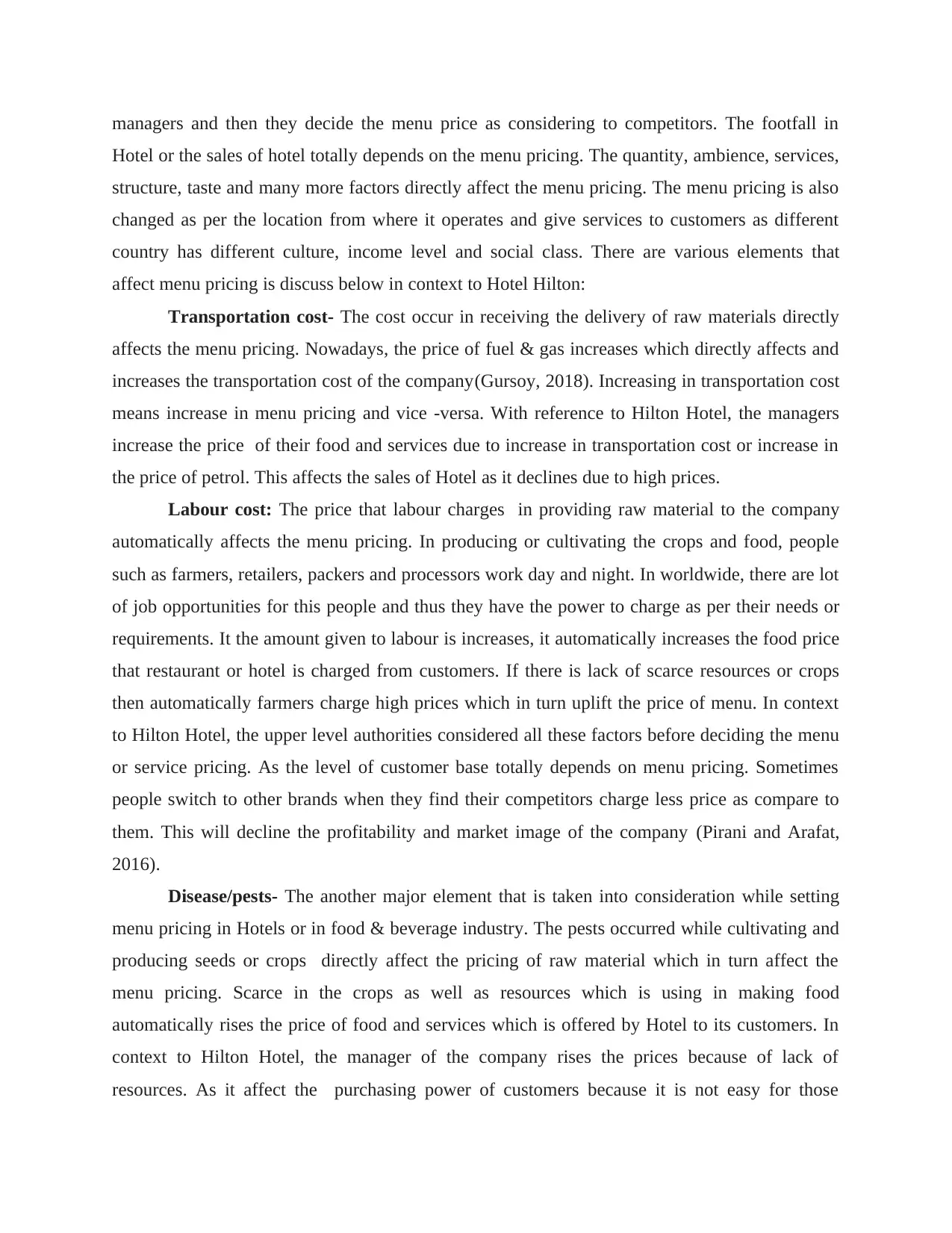
managers and then they decide the menu price as considering to competitors. The footfall in
Hotel or the sales of hotel totally depends on the menu pricing. The quantity, ambience, services,
structure, taste and many more factors directly affect the menu pricing. The menu pricing is also
changed as per the location from where it operates and give services to customers as different
country has different culture, income level and social class. There are various elements that
affect menu pricing is discuss below in context to Hotel Hilton:
Transportation cost- The cost occur in receiving the delivery of raw materials directly
affects the menu pricing. Nowadays, the price of fuel & gas increases which directly affects and
increases the transportation cost of the company(Gursoy, 2018). Increasing in transportation cost
means increase in menu pricing and vice -versa. With reference to Hilton Hotel, the managers
increase the price of their food and services due to increase in transportation cost or increase in
the price of petrol. This affects the sales of Hotel as it declines due to high prices.
Labour cost: The price that labour charges in providing raw material to the company
automatically affects the menu pricing. In producing or cultivating the crops and food, people
such as farmers, retailers, packers and processors work day and night. In worldwide, there are lot
of job opportunities for this people and thus they have the power to charge as per their needs or
requirements. It the amount given to labour is increases, it automatically increases the food price
that restaurant or hotel is charged from customers. If there is lack of scarce resources or crops
then automatically farmers charge high prices which in turn uplift the price of menu. In context
to Hilton Hotel, the upper level authorities considered all these factors before deciding the menu
or service pricing. As the level of customer base totally depends on menu pricing. Sometimes
people switch to other brands when they find their competitors charge less price as compare to
them. This will decline the profitability and market image of the company (Pirani and Arafat,
2016).
Disease/pests- The another major element that is taken into consideration while setting
menu pricing in Hotels or in food & beverage industry. The pests occurred while cultivating and
producing seeds or crops directly affect the pricing of raw material which in turn affect the
menu pricing. Scarce in the crops as well as resources which is using in making food
automatically rises the price of food and services which is offered by Hotel to its customers. In
context to Hilton Hotel, the manager of the company rises the prices because of lack of
resources. As it affect the purchasing power of customers because it is not easy for those
Hotel or the sales of hotel totally depends on the menu pricing. The quantity, ambience, services,
structure, taste and many more factors directly affect the menu pricing. The menu pricing is also
changed as per the location from where it operates and give services to customers as different
country has different culture, income level and social class. There are various elements that
affect menu pricing is discuss below in context to Hotel Hilton:
Transportation cost- The cost occur in receiving the delivery of raw materials directly
affects the menu pricing. Nowadays, the price of fuel & gas increases which directly affects and
increases the transportation cost of the company(Gursoy, 2018). Increasing in transportation cost
means increase in menu pricing and vice -versa. With reference to Hilton Hotel, the managers
increase the price of their food and services due to increase in transportation cost or increase in
the price of petrol. This affects the sales of Hotel as it declines due to high prices.
Labour cost: The price that labour charges in providing raw material to the company
automatically affects the menu pricing. In producing or cultivating the crops and food, people
such as farmers, retailers, packers and processors work day and night. In worldwide, there are lot
of job opportunities for this people and thus they have the power to charge as per their needs or
requirements. It the amount given to labour is increases, it automatically increases the food price
that restaurant or hotel is charged from customers. If there is lack of scarce resources or crops
then automatically farmers charge high prices which in turn uplift the price of menu. In context
to Hilton Hotel, the upper level authorities considered all these factors before deciding the menu
or service pricing. As the level of customer base totally depends on menu pricing. Sometimes
people switch to other brands when they find their competitors charge less price as compare to
them. This will decline the profitability and market image of the company (Pirani and Arafat,
2016).
Disease/pests- The another major element that is taken into consideration while setting
menu pricing in Hotels or in food & beverage industry. The pests occurred while cultivating and
producing seeds or crops directly affect the pricing of raw material which in turn affect the
menu pricing. Scarce in the crops as well as resources which is using in making food
automatically rises the price of food and services which is offered by Hotel to its customers. In
context to Hilton Hotel, the manager of the company rises the prices because of lack of
resources. As it affect the purchasing power of customers because it is not easy for those
Paraphrase This Document
Need a fresh take? Get an instant paraphrase of this document with our AI Paraphraser
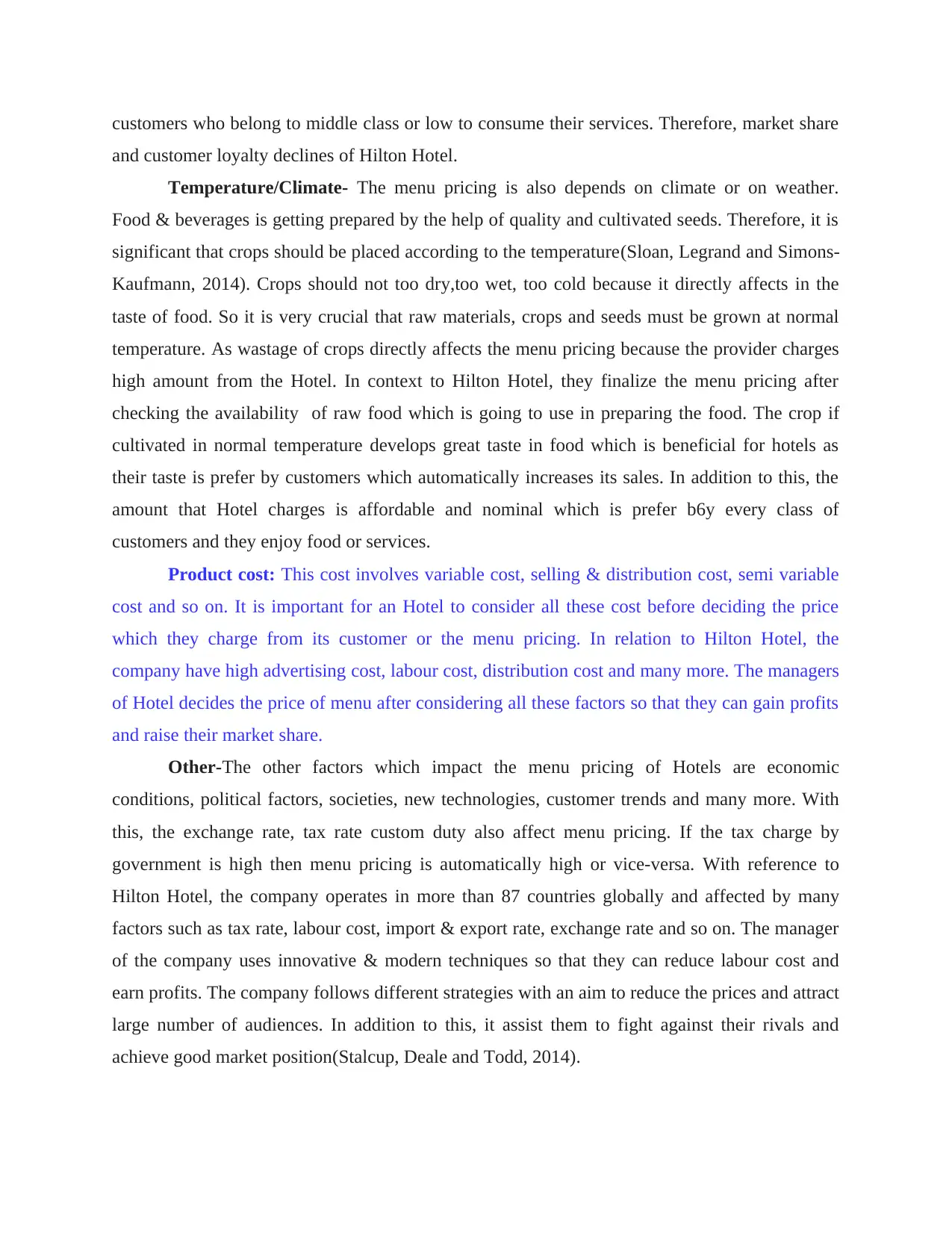
customers who belong to middle class or low to consume their services. Therefore, market share
and customer loyalty declines of Hilton Hotel.
Temperature/Climate- The menu pricing is also depends on climate or on weather.
Food & beverages is getting prepared by the help of quality and cultivated seeds. Therefore, it is
significant that crops should be placed according to the temperature(Sloan, Legrand and Simons-
Kaufmann, 2014). Crops should not too dry,too wet, too cold because it directly affects in the
taste of food. So it is very crucial that raw materials, crops and seeds must be grown at normal
temperature. As wastage of crops directly affects the menu pricing because the provider charges
high amount from the Hotel. In context to Hilton Hotel, they finalize the menu pricing after
checking the availability of raw food which is going to use in preparing the food. The crop if
cultivated in normal temperature develops great taste in food which is beneficial for hotels as
their taste is prefer by customers which automatically increases its sales. In addition to this, the
amount that Hotel charges is affordable and nominal which is prefer b6y every class of
customers and they enjoy food or services.
Product cost: This cost involves variable cost, selling & distribution cost, semi variable
cost and so on. It is important for an Hotel to consider all these cost before deciding the price
which they charge from its customer or the menu pricing. In relation to Hilton Hotel, the
company have high advertising cost, labour cost, distribution cost and many more. The managers
of Hotel decides the price of menu after considering all these factors so that they can gain profits
and raise their market share.
Other-The other factors which impact the menu pricing of Hotels are economic
conditions, political factors, societies, new technologies, customer trends and many more. With
this, the exchange rate, tax rate custom duty also affect menu pricing. If the tax charge by
government is high then menu pricing is automatically high or vice-versa. With reference to
Hilton Hotel, the company operates in more than 87 countries globally and affected by many
factors such as tax rate, labour cost, import & export rate, exchange rate and so on. The manager
of the company uses innovative & modern techniques so that they can reduce labour cost and
earn profits. The company follows different strategies with an aim to reduce the prices and attract
large number of audiences. In addition to this, it assist them to fight against their rivals and
achieve good market position(Stalcup, Deale and Todd, 2014).
and customer loyalty declines of Hilton Hotel.
Temperature/Climate- The menu pricing is also depends on climate or on weather.
Food & beverages is getting prepared by the help of quality and cultivated seeds. Therefore, it is
significant that crops should be placed according to the temperature(Sloan, Legrand and Simons-
Kaufmann, 2014). Crops should not too dry,too wet, too cold because it directly affects in the
taste of food. So it is very crucial that raw materials, crops and seeds must be grown at normal
temperature. As wastage of crops directly affects the menu pricing because the provider charges
high amount from the Hotel. In context to Hilton Hotel, they finalize the menu pricing after
checking the availability of raw food which is going to use in preparing the food. The crop if
cultivated in normal temperature develops great taste in food which is beneficial for hotels as
their taste is prefer by customers which automatically increases its sales. In addition to this, the
amount that Hotel charges is affordable and nominal which is prefer b6y every class of
customers and they enjoy food or services.
Product cost: This cost involves variable cost, selling & distribution cost, semi variable
cost and so on. It is important for an Hotel to consider all these cost before deciding the price
which they charge from its customer or the menu pricing. In relation to Hilton Hotel, the
company have high advertising cost, labour cost, distribution cost and many more. The managers
of Hotel decides the price of menu after considering all these factors so that they can gain profits
and raise their market share.
Other-The other factors which impact the menu pricing of Hotels are economic
conditions, political factors, societies, new technologies, customer trends and many more. With
this, the exchange rate, tax rate custom duty also affect menu pricing. If the tax charge by
government is high then menu pricing is automatically high or vice-versa. With reference to
Hilton Hotel, the company operates in more than 87 countries globally and affected by many
factors such as tax rate, labour cost, import & export rate, exchange rate and so on. The manager
of the company uses innovative & modern techniques so that they can reduce labour cost and
earn profits. The company follows different strategies with an aim to reduce the prices and attract
large number of audiences. In addition to this, it assist them to fight against their rivals and
achieve good market position(Stalcup, Deale and Todd, 2014).
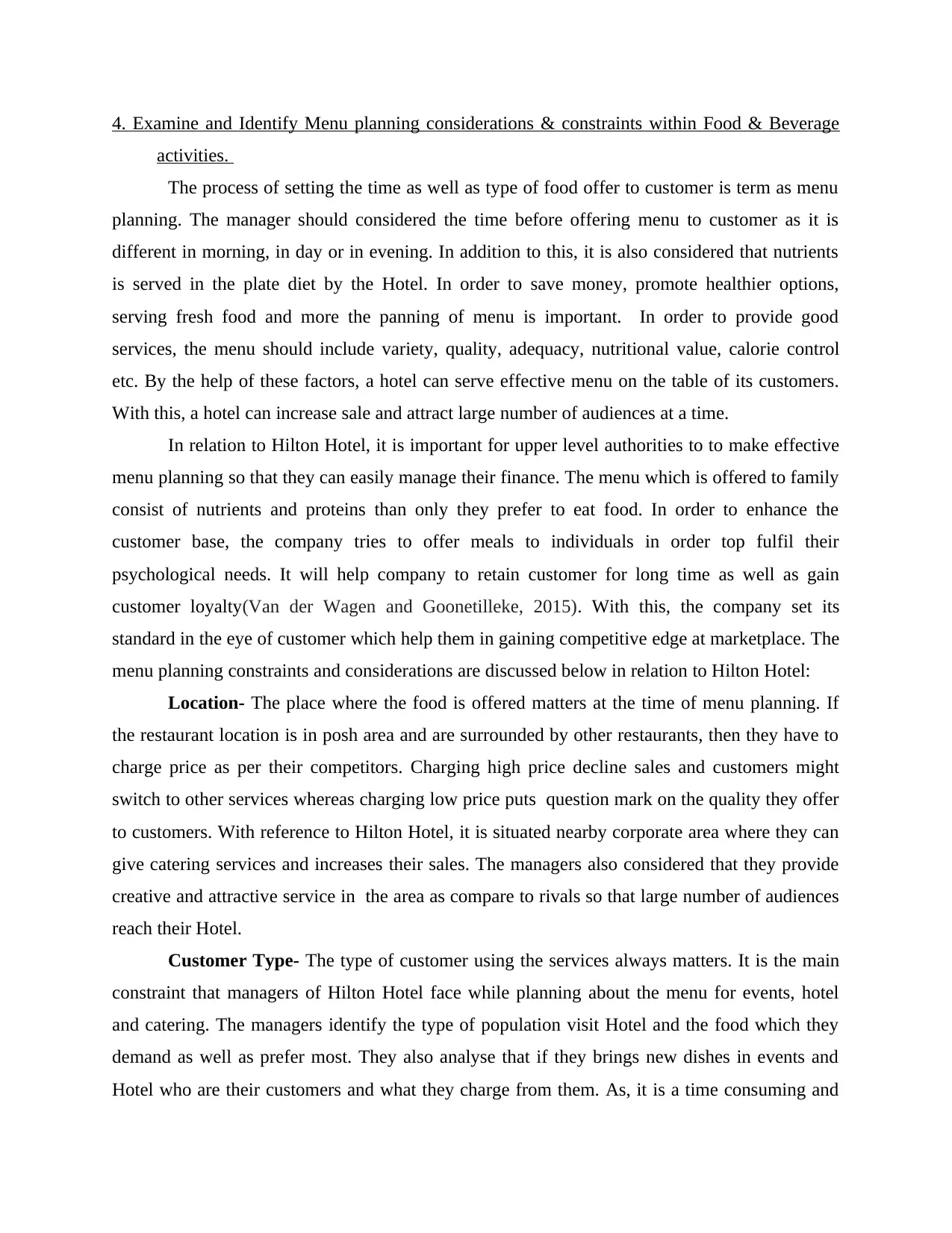
4. Examine and Identify Menu planning considerations & constraints within Food & Beverage
activities.
The process of setting the time as well as type of food offer to customer is term as menu
planning. The manager should considered the time before offering menu to customer as it is
different in morning, in day or in evening. In addition to this, it is also considered that nutrients
is served in the plate diet by the Hotel. In order to save money, promote healthier options,
serving fresh food and more the panning of menu is important. In order to provide good
services, the menu should include variety, quality, adequacy, nutritional value, calorie control
etc. By the help of these factors, a hotel can serve effective menu on the table of its customers.
With this, a hotel can increase sale and attract large number of audiences at a time.
In relation to Hilton Hotel, it is important for upper level authorities to to make effective
menu planning so that they can easily manage their finance. The menu which is offered to family
consist of nutrients and proteins than only they prefer to eat food. In order to enhance the
customer base, the company tries to offer meals to individuals in order top fulfil their
psychological needs. It will help company to retain customer for long time as well as gain
customer loyalty(Van der Wagen and Goonetilleke, 2015). With this, the company set its
standard in the eye of customer which help them in gaining competitive edge at marketplace. The
menu planning constraints and considerations are discussed below in relation to Hilton Hotel:
Location- The place where the food is offered matters at the time of menu planning. If
the restaurant location is in posh area and are surrounded by other restaurants, then they have to
charge price as per their competitors. Charging high price decline sales and customers might
switch to other services whereas charging low price puts question mark on the quality they offer
to customers. With reference to Hilton Hotel, it is situated nearby corporate area where they can
give catering services and increases their sales. The managers also considered that they provide
creative and attractive service in the area as compare to rivals so that large number of audiences
reach their Hotel.
Customer Type- The type of customer using the services always matters. It is the main
constraint that managers of Hilton Hotel face while planning about the menu for events, hotel
and catering. The managers identify the type of population visit Hotel and the food which they
demand as well as prefer most. They also analyse that if they brings new dishes in events and
Hotel who are their customers and what they charge from them. As, it is a time consuming and
activities.
The process of setting the time as well as type of food offer to customer is term as menu
planning. The manager should considered the time before offering menu to customer as it is
different in morning, in day or in evening. In addition to this, it is also considered that nutrients
is served in the plate diet by the Hotel. In order to save money, promote healthier options,
serving fresh food and more the panning of menu is important. In order to provide good
services, the menu should include variety, quality, adequacy, nutritional value, calorie control
etc. By the help of these factors, a hotel can serve effective menu on the table of its customers.
With this, a hotel can increase sale and attract large number of audiences at a time.
In relation to Hilton Hotel, it is important for upper level authorities to to make effective
menu planning so that they can easily manage their finance. The menu which is offered to family
consist of nutrients and proteins than only they prefer to eat food. In order to enhance the
customer base, the company tries to offer meals to individuals in order top fulfil their
psychological needs. It will help company to retain customer for long time as well as gain
customer loyalty(Van der Wagen and Goonetilleke, 2015). With this, the company set its
standard in the eye of customer which help them in gaining competitive edge at marketplace. The
menu planning constraints and considerations are discussed below in relation to Hilton Hotel:
Location- The place where the food is offered matters at the time of menu planning. If
the restaurant location is in posh area and are surrounded by other restaurants, then they have to
charge price as per their competitors. Charging high price decline sales and customers might
switch to other services whereas charging low price puts question mark on the quality they offer
to customers. With reference to Hilton Hotel, it is situated nearby corporate area where they can
give catering services and increases their sales. The managers also considered that they provide
creative and attractive service in the area as compare to rivals so that large number of audiences
reach their Hotel.
Customer Type- The type of customer using the services always matters. It is the main
constraint that managers of Hilton Hotel face while planning about the menu for events, hotel
and catering. The managers identify the type of population visit Hotel and the food which they
demand as well as prefer most. They also analyse that if they brings new dishes in events and
Hotel who are their customers and what they charge from them. As, it is a time consuming and
⊘ This is a preview!⊘
Do you want full access?
Subscribe today to unlock all pages.

Trusted by 1+ million students worldwide
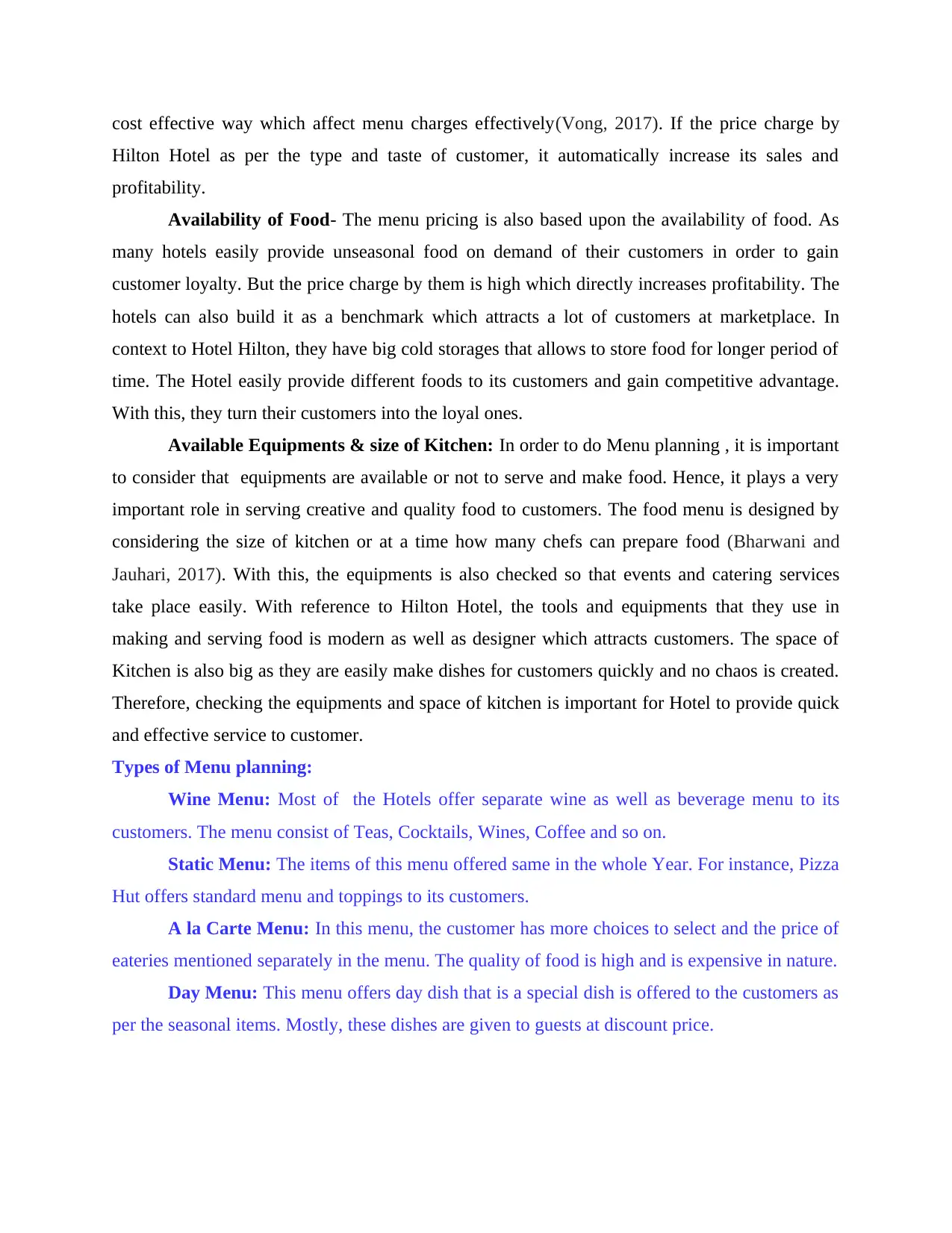
cost effective way which affect menu charges effectively(Vong, 2017). If the price charge by
Hilton Hotel as per the type and taste of customer, it automatically increase its sales and
profitability.
Availability of Food- The menu pricing is also based upon the availability of food. As
many hotels easily provide unseasonal food on demand of their customers in order to gain
customer loyalty. But the price charge by them is high which directly increases profitability. The
hotels can also build it as a benchmark which attracts a lot of customers at marketplace. In
context to Hotel Hilton, they have big cold storages that allows to store food for longer period of
time. The Hotel easily provide different foods to its customers and gain competitive advantage.
With this, they turn their customers into the loyal ones.
Available Equipments & size of Kitchen: In order to do Menu planning , it is important
to consider that equipments are available or not to serve and make food. Hence, it plays a very
important role in serving creative and quality food to customers. The food menu is designed by
considering the size of kitchen or at a time how many chefs can prepare food (Bharwani and
Jauhari, 2017). With this, the equipments is also checked so that events and catering services
take place easily. With reference to Hilton Hotel, the tools and equipments that they use in
making and serving food is modern as well as designer which attracts customers. The space of
Kitchen is also big as they are easily make dishes for customers quickly and no chaos is created.
Therefore, checking the equipments and space of kitchen is important for Hotel to provide quick
and effective service to customer.
Types of Menu planning:
Wine Menu: Most of the Hotels offer separate wine as well as beverage menu to its
customers. The menu consist of Teas, Cocktails, Wines, Coffee and so on.
Static Menu: The items of this menu offered same in the whole Year. For instance, Pizza
Hut offers standard menu and toppings to its customers.
A la Carte Menu: In this menu, the customer has more choices to select and the price of
eateries mentioned separately in the menu. The quality of food is high and is expensive in nature.
Day Menu: This menu offers day dish that is a special dish is offered to the customers as
per the seasonal items. Mostly, these dishes are given to guests at discount price.
Hilton Hotel as per the type and taste of customer, it automatically increase its sales and
profitability.
Availability of Food- The menu pricing is also based upon the availability of food. As
many hotels easily provide unseasonal food on demand of their customers in order to gain
customer loyalty. But the price charge by them is high which directly increases profitability. The
hotels can also build it as a benchmark which attracts a lot of customers at marketplace. In
context to Hotel Hilton, they have big cold storages that allows to store food for longer period of
time. The Hotel easily provide different foods to its customers and gain competitive advantage.
With this, they turn their customers into the loyal ones.
Available Equipments & size of Kitchen: In order to do Menu planning , it is important
to consider that equipments are available or not to serve and make food. Hence, it plays a very
important role in serving creative and quality food to customers. The food menu is designed by
considering the size of kitchen or at a time how many chefs can prepare food (Bharwani and
Jauhari, 2017). With this, the equipments is also checked so that events and catering services
take place easily. With reference to Hilton Hotel, the tools and equipments that they use in
making and serving food is modern as well as designer which attracts customers. The space of
Kitchen is also big as they are easily make dishes for customers quickly and no chaos is created.
Therefore, checking the equipments and space of kitchen is important for Hotel to provide quick
and effective service to customer.
Types of Menu planning:
Wine Menu: Most of the Hotels offer separate wine as well as beverage menu to its
customers. The menu consist of Teas, Cocktails, Wines, Coffee and so on.
Static Menu: The items of this menu offered same in the whole Year. For instance, Pizza
Hut offers standard menu and toppings to its customers.
A la Carte Menu: In this menu, the customer has more choices to select and the price of
eateries mentioned separately in the menu. The quality of food is high and is expensive in nature.
Day Menu: This menu offers day dish that is a special dish is offered to the customers as
per the seasonal items. Mostly, these dishes are given to guests at discount price.
Paraphrase This Document
Need a fresh take? Get an instant paraphrase of this document with our AI Paraphraser
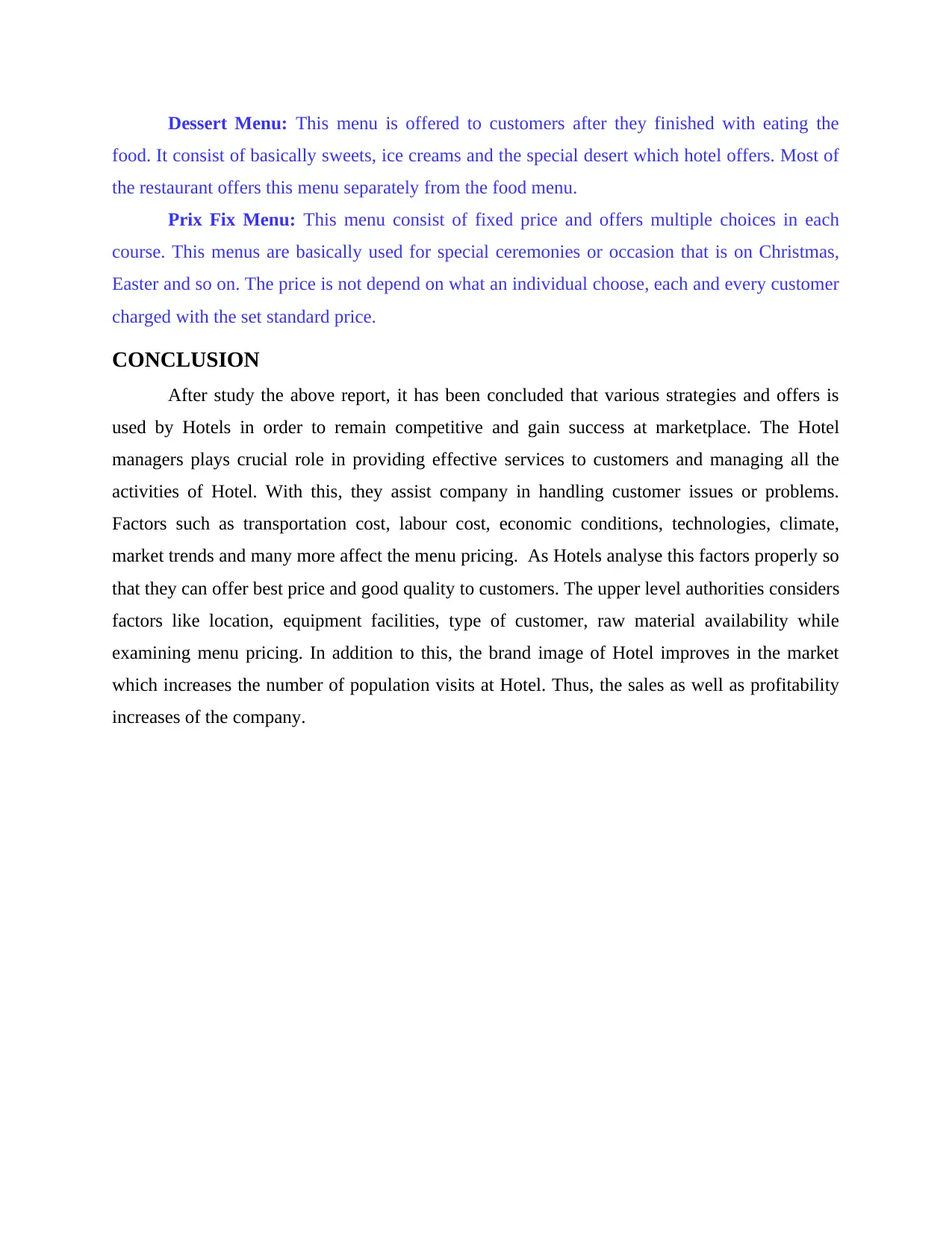
Dessert Menu: This menu is offered to customers after they finished with eating the
food. It consist of basically sweets, ice creams and the special desert which hotel offers. Most of
the restaurant offers this menu separately from the food menu.
Prix Fix Menu: This menu consist of fixed price and offers multiple choices in each
course. This menus are basically used for special ceremonies or occasion that is on Christmas,
Easter and so on. The price is not depend on what an individual choose, each and every customer
charged with the set standard price.
CONCLUSION
After study the above report, it has been concluded that various strategies and offers is
used by Hotels in order to remain competitive and gain success at marketplace. The Hotel
managers plays crucial role in providing effective services to customers and managing all the
activities of Hotel. With this, they assist company in handling customer issues or problems.
Factors such as transportation cost, labour cost, economic conditions, technologies, climate,
market trends and many more affect the menu pricing. As Hotels analyse this factors properly so
that they can offer best price and good quality to customers. The upper level authorities considers
factors like location, equipment facilities, type of customer, raw material availability while
examining menu pricing. In addition to this, the brand image of Hotel improves in the market
which increases the number of population visits at Hotel. Thus, the sales as well as profitability
increases of the company.
food. It consist of basically sweets, ice creams and the special desert which hotel offers. Most of
the restaurant offers this menu separately from the food menu.
Prix Fix Menu: This menu consist of fixed price and offers multiple choices in each
course. This menus are basically used for special ceremonies or occasion that is on Christmas,
Easter and so on. The price is not depend on what an individual choose, each and every customer
charged with the set standard price.
CONCLUSION
After study the above report, it has been concluded that various strategies and offers is
used by Hotels in order to remain competitive and gain success at marketplace. The Hotel
managers plays crucial role in providing effective services to customers and managing all the
activities of Hotel. With this, they assist company in handling customer issues or problems.
Factors such as transportation cost, labour cost, economic conditions, technologies, climate,
market trends and many more affect the menu pricing. As Hotels analyse this factors properly so
that they can offer best price and good quality to customers. The upper level authorities considers
factors like location, equipment facilities, type of customer, raw material availability while
examining menu pricing. In addition to this, the brand image of Hotel improves in the market
which increases the number of population visits at Hotel. Thus, the sales as well as profitability
increases of the company.
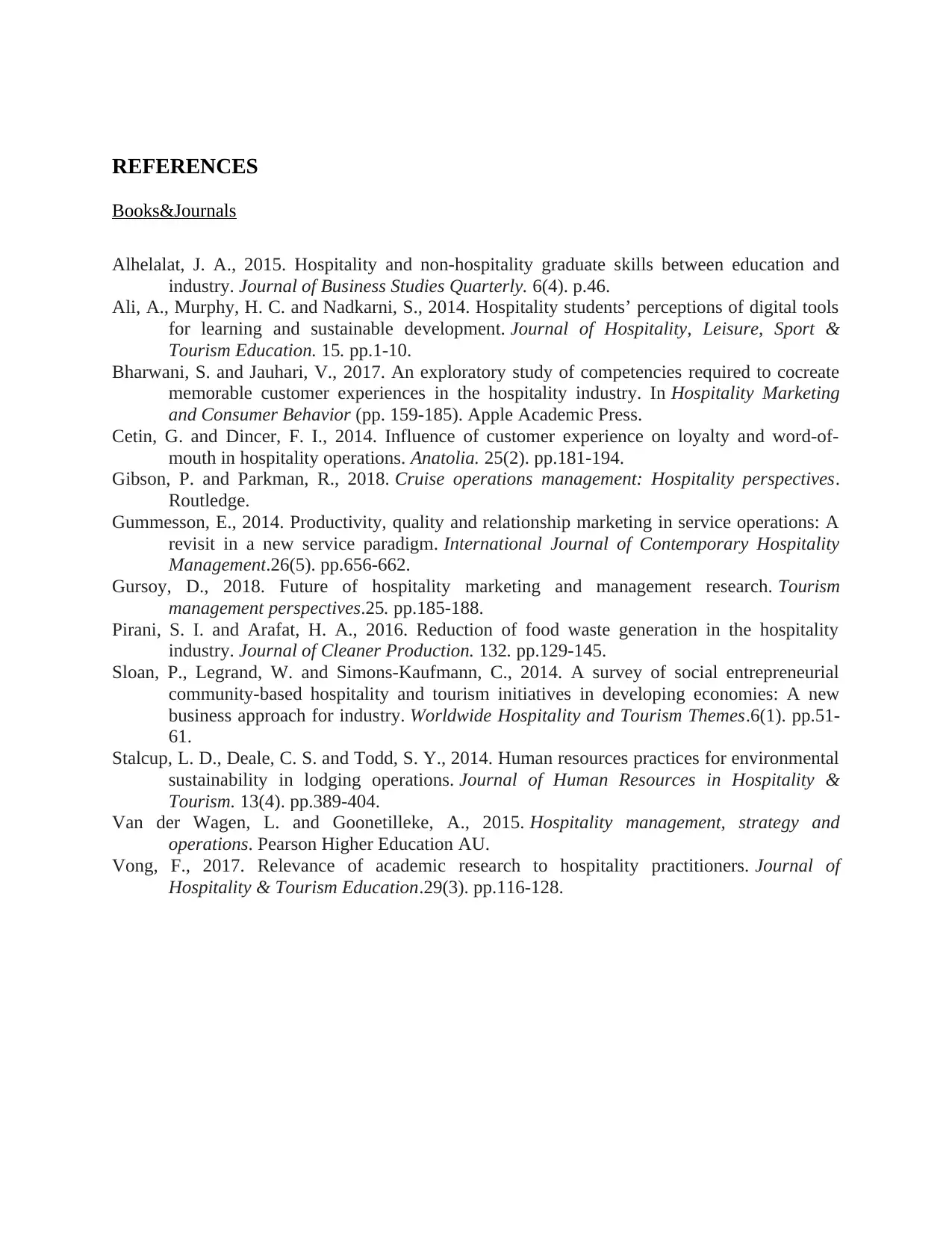
REFERENCES
Books&Journals
Alhelalat, J. A., 2015. Hospitality and non-hospitality graduate skills between education and
industry. Journal of Business Studies Quarterly. 6(4). p.46.
Ali, A., Murphy, H. C. and Nadkarni, S., 2014. Hospitality students’ perceptions of digital tools
for learning and sustainable development. Journal of Hospitality, Leisure, Sport &
Tourism Education. 15. pp.1-10.
Bharwani, S. and Jauhari, V., 2017. An exploratory study of competencies required to cocreate
memorable customer experiences in the hospitality industry. In Hospitality Marketing
and Consumer Behavior (pp. 159-185). Apple Academic Press.
Cetin, G. and Dincer, F. I., 2014. Influence of customer experience on loyalty and word-of-
mouth in hospitality operations. Anatolia. 25(2). pp.181-194.
Gibson, P. and Parkman, R., 2018. Cruise operations management: Hospitality perspectives.
Routledge.
Gummesson, E., 2014. Productivity, quality and relationship marketing in service operations: A
revisit in a new service paradigm. International Journal of Contemporary Hospitality
Management.26(5). pp.656-662.
Gursoy, D., 2018. Future of hospitality marketing and management research. Tourism
management perspectives.25. pp.185-188.
Pirani, S. I. and Arafat, H. A., 2016. Reduction of food waste generation in the hospitality
industry. Journal of Cleaner Production. 132. pp.129-145.
Sloan, P., Legrand, W. and Simons-Kaufmann, C., 2014. A survey of social entrepreneurial
community-based hospitality and tourism initiatives in developing economies: A new
business approach for industry. Worldwide Hospitality and Tourism Themes.6(1). pp.51-
61.
Stalcup, L. D., Deale, C. S. and Todd, S. Y., 2014. Human resources practices for environmental
sustainability in lodging operations. Journal of Human Resources in Hospitality &
Tourism. 13(4). pp.389-404.
Van der Wagen, L. and Goonetilleke, A., 2015. Hospitality management, strategy and
operations. Pearson Higher Education AU.
Vong, F., 2017. Relevance of academic research to hospitality practitioners. Journal of
Hospitality & Tourism Education.29(3). pp.116-128.
Books&Journals
Alhelalat, J. A., 2015. Hospitality and non-hospitality graduate skills between education and
industry. Journal of Business Studies Quarterly. 6(4). p.46.
Ali, A., Murphy, H. C. and Nadkarni, S., 2014. Hospitality students’ perceptions of digital tools
for learning and sustainable development. Journal of Hospitality, Leisure, Sport &
Tourism Education. 15. pp.1-10.
Bharwani, S. and Jauhari, V., 2017. An exploratory study of competencies required to cocreate
memorable customer experiences in the hospitality industry. In Hospitality Marketing
and Consumer Behavior (pp. 159-185). Apple Academic Press.
Cetin, G. and Dincer, F. I., 2014. Influence of customer experience on loyalty and word-of-
mouth in hospitality operations. Anatolia. 25(2). pp.181-194.
Gibson, P. and Parkman, R., 2018. Cruise operations management: Hospitality perspectives.
Routledge.
Gummesson, E., 2014. Productivity, quality and relationship marketing in service operations: A
revisit in a new service paradigm. International Journal of Contemporary Hospitality
Management.26(5). pp.656-662.
Gursoy, D., 2018. Future of hospitality marketing and management research. Tourism
management perspectives.25. pp.185-188.
Pirani, S. I. and Arafat, H. A., 2016. Reduction of food waste generation in the hospitality
industry. Journal of Cleaner Production. 132. pp.129-145.
Sloan, P., Legrand, W. and Simons-Kaufmann, C., 2014. A survey of social entrepreneurial
community-based hospitality and tourism initiatives in developing economies: A new
business approach for industry. Worldwide Hospitality and Tourism Themes.6(1). pp.51-
61.
Stalcup, L. D., Deale, C. S. and Todd, S. Y., 2014. Human resources practices for environmental
sustainability in lodging operations. Journal of Human Resources in Hospitality &
Tourism. 13(4). pp.389-404.
Van der Wagen, L. and Goonetilleke, A., 2015. Hospitality management, strategy and
operations. Pearson Higher Education AU.
Vong, F., 2017. Relevance of academic research to hospitality practitioners. Journal of
Hospitality & Tourism Education.29(3). pp.116-128.
⊘ This is a preview!⊘
Do you want full access?
Subscribe today to unlock all pages.

Trusted by 1+ million students worldwide
1 out of 12
Related Documents
Your All-in-One AI-Powered Toolkit for Academic Success.
+13062052269
info@desklib.com
Available 24*7 on WhatsApp / Email
![[object Object]](/_next/static/media/star-bottom.7253800d.svg)
Unlock your academic potential
Copyright © 2020–2025 A2Z Services. All Rights Reserved. Developed and managed by ZUCOL.





